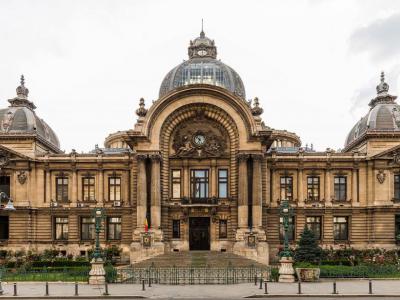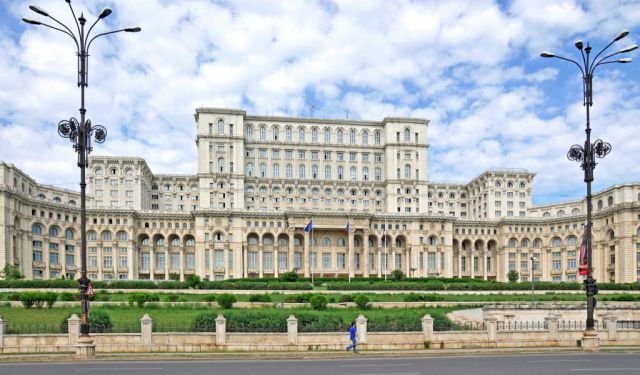CEC Palace, Bucharest
The CEC Palace (Palatul CEC), gracing the heart of Bucharest’s iconic Victory Avenue (Calea Victoriei), is a breathtaking symbol of the city’s late‑19th‑century architectural renaissance. Constructed between 1897 and 1900 under the eye of French architect Paul Gottereau and Romanian firm Ion Socolescu, this elegant Beaux‑Arts masterpiece was commissioned as the headquarters for the nation’s oldest savings institution, the Casa de Depuneri, Consemnațiuni și Economie. Its ornate façade, crowned by a magnificent central glass-and-metal dome and flanked by four smaller cupolas, anchors the streetscape with grace and grandeur.
Beneath its soaring arches and atop elegant Dobrogea marble steps lies a building rich in history and craftsmanship. The palace’s design nods to late‑19th‑century Romanian aspirations toward Western European refinement, mirroring Bucharest’s moniker as “Little Paris”. Statues of Mercury and Demeter adorn the entrance, symbolizing commerce and prosperity, while coats of arms and decorative gables add layers of emblematic meaning. Remarkably resilient, the structure withstood the seismic shocks of the 1940 and 1977 earthquakes, as well as wartime bombings, emerging much as it was originally envisioned.
Though the CEC Palace remains an active working bank and closed to the general public, it holds a private allure few can resist. Guided tours for special events sometimes grant rare access to the palace’s sumptuous interior-featuring ornate wood-carved council chambers and opulent frescoes-including the mythic Fortuna mural. Whether bathed in daylight or softly illuminated at dusk, the palace façade itself is a visual feast, offering unforgettable photo opportunities.
For tourists exploring Bucharest’s storied avenues, a stroll along Victory Avenue (Calea Victoriei) presents the CEC Palace as an essential stop. Opposite the National Museum of Romanian History, it nestles among storied neighbors like the Athénée Palace and Cantacuzino Palace. Though you may only view it from the outside, its presence infuses the city with architectural poetry-an emblem of Romania’s transition into modern Europe and an enduring jewel in Bucharest’s urban crown.
Beneath its soaring arches and atop elegant Dobrogea marble steps lies a building rich in history and craftsmanship. The palace’s design nods to late‑19th‑century Romanian aspirations toward Western European refinement, mirroring Bucharest’s moniker as “Little Paris”. Statues of Mercury and Demeter adorn the entrance, symbolizing commerce and prosperity, while coats of arms and decorative gables add layers of emblematic meaning. Remarkably resilient, the structure withstood the seismic shocks of the 1940 and 1977 earthquakes, as well as wartime bombings, emerging much as it was originally envisioned.
Though the CEC Palace remains an active working bank and closed to the general public, it holds a private allure few can resist. Guided tours for special events sometimes grant rare access to the palace’s sumptuous interior-featuring ornate wood-carved council chambers and opulent frescoes-including the mythic Fortuna mural. Whether bathed in daylight or softly illuminated at dusk, the palace façade itself is a visual feast, offering unforgettable photo opportunities.
For tourists exploring Bucharest’s storied avenues, a stroll along Victory Avenue (Calea Victoriei) presents the CEC Palace as an essential stop. Opposite the National Museum of Romanian History, it nestles among storied neighbors like the Athénée Palace and Cantacuzino Palace. Though you may only view it from the outside, its presence infuses the city with architectural poetry-an emblem of Romania’s transition into modern Europe and an enduring jewel in Bucharest’s urban crown.
Want to visit this sight? Check out these Self-Guided Walking Tours in Bucharest. Alternatively, you can download the mobile app "GPSmyCity: Walks in 1K+ Cities" from Apple App Store or Google Play Store. The app turns your mobile device to a personal tour guide and it works offline, so no data plan is needed when traveling abroad.
CEC Palace on Map
Sight Name: CEC Palace
Sight Location: Bucharest, Romania (See walking tours in Bucharest)
Sight Type: Attraction/Landmark
Sight Location: Bucharest, Romania (See walking tours in Bucharest)
Sight Type: Attraction/Landmark
Walking Tours in Bucharest, Romania
Create Your Own Walk in Bucharest
Creating your own self-guided walk in Bucharest is easy and fun. Choose the city attractions that you want to see and a walk route map will be created just for you. You can even set your hotel as the start point of the walk.
Bucharest Introduction Walking Tour
Bucharest, the capital and cultural center of Romania, is one of the largest cities in Southeastern Europe.
The name București has an unverified origin. Tradition links it to the guy named Bucur, who (according to various legends) was either a prince, outlaw, fisherman, shepherd or a hunter. The Romanian word “bucurie” means joy (happiness), which in turn explains one of Bucharest's... view more
Tour Duration: 2 Hour(s)
Travel Distance: 3.7 Km or 2.3 Miles
The name București has an unverified origin. Tradition links it to the guy named Bucur, who (according to various legends) was either a prince, outlaw, fisherman, shepherd or a hunter. The Romanian word “bucurie” means joy (happiness), which in turn explains one of Bucharest's... view more
Tour Duration: 2 Hour(s)
Travel Distance: 3.7 Km or 2.3 Miles
Old Town Walking Tour
The Historical Center of Bucharest, or the Old Town, as the locals habitually refer to it, is one of the most beloved and attractive areas in the Romanian capital. The neighborhood is really beautiful a place to visit, and you can walk into it pretty much from anywhere in central Bucharest. Ion Constantin Brătianu Boulevard crosses the historic heart of the city from Piata Universitate... view more
Tour Duration: 2 Hour(s)
Travel Distance: 1.9 Km or 1.2 Miles
Tour Duration: 2 Hour(s)
Travel Distance: 1.9 Km or 1.2 Miles
Useful Travel Guides for Planning Your Trip
16 Uniquely Romanian Things To Buy in Bucharest
Nicknamed "Little Paris", today's Bucharest is the capital of a vibrant European nation, known as Romania, with lots of history and great cultural heritage - spanning from centuries-old rural traditions to New Wave cinema. Keen on rustic stuff, Romanians carefully preserve their...






